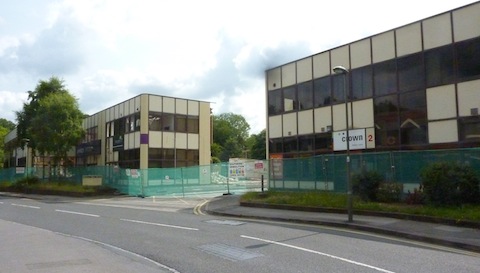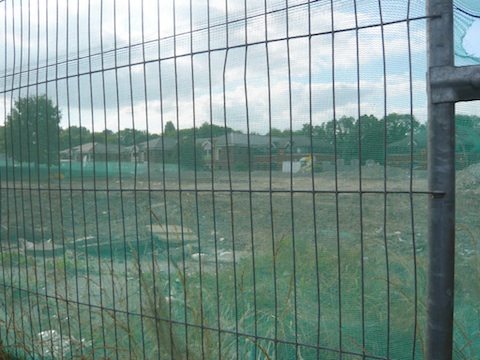 Abraham Lincoln
If given the truth, the people can be depended upon to meet any national crisis...
Abraham Lincoln
If given the truth, the people can be depended upon to meet any national crisis...
 Guildford news...
for Guildford people, brought to you by Guildford reporters - Guildford's own news service
Guildford news...
for Guildford people, brought to you by Guildford reporters - Guildford's own news service
Opinion: Dapdune Wharf – Opening Up Our River Should Have Begun Here
Published on: 17 Sep, 2013
Updated on: 17 Sep, 2013
By Martin Giles
Riverside Dapdune Wharf is an island of tranquillity in our town. Once a bustling centre of barge construction, it is now a quiet and pretty relic, beautifully maintained by the National Trust.
What a relief then for the trust and current visitors, enjoying the location’s semi rural feel, that the yellow plastic eyesore, an office block opposite, has disappeared. While it stood the best view of Dapdune Wharf was from the opposite bank with one’s back to the modern monstrosity.
It represented all that is the worst of the treatment of our riverside in Guildford. It might have been understandable for the Victorians, and those from earlier periods, to simply view the river as an industrial asset, a source of power to be exploited, but surely as we moved into the twentieth century there should have been more enlightened and imaginative views on how we could enjoy this natural amenity, aesthetically and for recreation.
The redevelopment of the site offered a chance to take a small step towards that goal. The ugly characterless office blocks could have been replaced with much needed housing that could have reflected the style of the Wharf cottages. They could have been pleasant to live in and enhanced the view.
Instead we are to see yet another office block emerge. It might not look as bad as the last one. It is hard to imagine that it could be. But it is unlikely to blend in, much less attract admiring glances.
We should not rush to condemn our local councillors and planning officers though. They are normally very constrained in their decisions. If an office block stood there before it is almost impossible to refuse an application to redevelop for a similar purpose.
And in all planning decisions is the threat of the Planning Inspectorate. From a range of nearly 200 miles they hang like the sword of Damocles over all our local planning decisions making them almost a matter of form, often to the puzzlement of both applicants and objectors who imagine councillors to have real discretion.
If this government really wants localism to blossom and save some money they could do a lot worse that shutting down this damaging agency. But of course they won’t because for all their fine words about devolving power downgrades they need the planning inspectorate to make sure that new houses, for an ever increasing population, are built and growth targets met, regardless of local sentiment.
There is no doubt this is a difficult problem and there is also no doubt that none of the main political parties really want to face up to it. I really hope that I am being too pessimistic, that our new local plan will be a template for consensual development that can open up our river as we all want.
I want to believe it but I can’t. The memory of one man from Bristol overriding a unanimous vision by our elected councillors over the development in Green Lane is still too fresh in my mind.
Responses to Opinion: Dapdune Wharf – Opening Up Our River Should Have Begun Here
Leave a Comment Cancel replyPlease see our comments policy. All comments are moderated and may take time to appear. Full names, or at least initial and surname, must be given.
Recent Articles
- City Earn Themselves a Three Point Christmas Present
- Mayor’s Diary: December 23 – January 4
- Inquest into Prisoner Death at Surrey Prison
- Notice: Family Fun Craft Activity – January 3
- Scouting Year Ends on a High
- Memories of the Dennis Bros Christmas Party
- Letter: The Devolution White Paper is Good News for Surrey
- Notice: Come and Make a Christmas Cracker
- Benefits of Assisted Living Scheme Outweigh Harm to Designated Landscape GBC Planners Decide
- Letter: Councillor’s Statement is Misleading


Recent Comments
- Derek Payne on Dumped E-bike Provokes Questions
- John Perkins on Two Unitary Authorities, One Elected Mayor – Most Likely Devolution Outcome for Surrey
- Dave Middleton on Two Unitary Authorities, One Elected Mayor – Most Likely Devolution Outcome for Surrey
- Nigel Keane on Two Unitary Authorities, One Elected Mayor – Most Likely Devolution Outcome for Surrey
- Paul Robinson on Dumped E-bike Provokes Questions
- Tim Down on Letter: Will New Bridge Really Speed Up Journey Times?
Search in Site
Media Gallery
Dragon Interview: Local Artist Leaves Her Mark At One of England’s Most Historic Buildings
January 21, 2023 / No Comment / Read MoreDragon Interview: Lib Dem Planning Chair: ‘Current Policy Doesn’t Work for Local People’
January 19, 2023 / No Comment / Read MoreA3 Tunnel in Guildford ‘Necessary’ for New Homes, Says Guildford’s MP
January 10, 2023 / No Comment / Read More‘Madness’ for London Road Scheme to Go Ahead Against ‘Huge Opposition’, Says SCC Leader
January 6, 2023 / No Comment / Read MoreCouncillor’s Son Starts Campaign for More Consultation on North Street Plan
December 30, 2022 / No Comment / Read MoreCounty Council Climbs Down Over London Road Works – Further ‘Engagement’ Period Announced
December 14, 2022 / No Comment / Read MoreDragon Interview: GBC Reaction to the Government’s Expected Decision to Relax Housing Targets
December 7, 2022 / No Comment / Read MoreHow Can Our Town Centre Businesses Recover? Watch the Shop Front Debate
May 18, 2020 / No Comment / Read More
















jim Allen
September 17, 2013 at 11:46 pm
As usual Martin hits the nail square on the head again……. Hopefully a sensible traffic plan and local plan reflecting the Neighbourhood plan survey findings will go some way to curb the Bristolians ambitions in Surrey.
Bibhas Neogi
September 21, 2013 at 9:18 am
Maybe it wasn’t possible before to change usage from office to residential. But now there is hope. For the future the Councils may take advantage of relaxation of planning rules as published by the Department for Communities and Local Government.
Relaxation of planning rules for change of
use from offices to residential
ISBN: 978-1-4098- 3890-6
May 2013
I quote from the above document,-
“Evidence Base (for summary sheets)
Problem under consideration
The Government is committed to increasing the rate of house-building, making housing supply more responsive to changes in demand.Seasonally adjusted housing starts are now 58% above the trough in March 2009 but are still 45% below the March quarter 2007 peak and housing completions are 42% below their March quarter 2007 peak . Annual housing supply in England amounted to 134,900 net additional dwellings in 2011 to 2012, an 11%
increase in net additional dwellings from 2010 to 2011 although the number of households in England is projected to grow by 221,000 per year In part this is due to wider market conditions, but the Government believes that aspects of the current land use planning system also play a part.
The Government is committed to a raft of reforms designed to address the chronic under supply of housing. It is therefore proposing to amend the planning rules to make it easier to change use from office to residential use.”